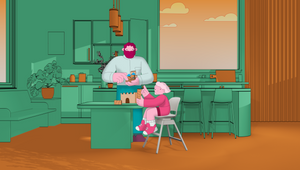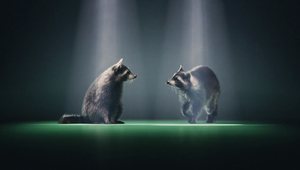
How The Mill and The Guardian Are Pioneering VR Journalism with ‘6x9’

The advertising and creative worlds have got very excited about virtual reality, but beneath the hype there are questions about how useful it actually is. This recent project from The Mill and The Guardian newspaper is a brilliant example for VR being used for a very powerful reason. It was created to draw attention to psychological damage that solitary confinement in prisons can cause, by placing the viewer in a cramped 6 foot by 9 foot cell as former prisoners share their stories. It’s devastatingly simple and a challenging experience that reveals a transformative step forward for interactive journalism.
LBB’s Addison Capper spoke to Mill Creative Director Carl Addy and Mill Creative Technologist Kevin Young.
LBB> What kind of research was involved for this project? Were you able to speak to people who have endured solitary confinement? Did you get to experience it yourself?
Carl Addy, Mill Creative Director>The Mill worked from first-person accounts and documentaries as references for both cell design, objects in the cell and spatial audio capture. The Guardian interviewed seven former prisoners who were in solitary confinement for between one and eight years in California and New York. Throughout “6x9” the viewer hears audio from interviews with these former prisoners who speak about their personal experiences and explain to the viewer about the sorts of things they can expect during the film.
Every hallucination and traumatic experience is garnered from interviews with the prisoners and reports of academic psychologists Dr Terry Kupers and Dr Craig Haney. We researched a range of different cells to create a layout that represented what the most common, standardised cell looks like in solitary confinement, and everything that can be seen in the cell is based on first hand reports from officials and prisoners.
LBB> What were the most shocking or interesting things you discovered?
Carl Addy> It is shocking that approximately 100,000 people are in solitary confinement in the US, with some spending 22-24 hours a day in a cell with little to no human contact for days or even decades. Not a lot of people understand just how much it is happening and more particularly the length of time people can be subjected to it. It is shocking how easy it is to get stuck in a cycle of solitary confinement. How, once you are in for a stint you can easily accrue additional time for relatively minor infringements. And how hard it must be to not act up once you experience the effects of sensory deprivation. It is scary.
LBB> How did you work together with The Guardian on this project?
Carl Addy> It was a close collaboration between ourselves and the Guardian in what is essentially a well researched piece of journalistic filmmaking; a factual documentary that has been translated and directed in VR as an immersive experience. Using the Guardian’s impeccable research we were tasked to adapt a linear style narrative into a VR experience involving first person narrative and interactivity.
LBB> You consulted a number of psychology specialists. Who were they and what role did they play?
Carl Addy> The project team also worked closely with academic psychologists Dr Terry Kupers and Dr Craig Haney who have studied the effects of solitary confinement for decades. Interviewed for “6x9”, they explain the physiological effects the viewer experiences - from figures appearing in peripheral vision to vision blur and the sensation of floating. The psychologists help endorse the research with medical facts which in turn builds authenticity. This was incredibly helpful to build empathy; one cares because the content is real.
LBB> Obviously one of the biggest factors of solitary confinement is the sheer amount of time people spend in it. But you couldn’t put people into a 23-hour VR experience - so how did you convey that essence of longevity into the project?
Carl Addy> The entire user journey is designed to mimic what a prisoner goes through in solitary confinement. The user enters the experience expecting to watch a documentary but through the interactivity of their journey they encounter much of what prisoners have recorded experiencing. The user journey begins with a traditional narrated intro but soon becomes more immersive and is designed to give the user a sense of control. This control is then removed as the user enters a sequence of deteriorating psychological effects.
At the end of the journey they are left back in the original cell and even this mimics the trauma a prisoner faces; the helplessness of being stuck in this cycle regardless of the psychological damage caused by long term sensory deprivation. The task was to really give a sense of what isolation feels like. By giving people a visceral experience of solitary confinement we were able to emotionally connect them to the cause. One of the great tools when directing in VR is body language. Looking at how people react when in an unfamiliar and uncomfortable setting, you can see how they become more absorbed in the space, more closed in and self-protective. If used right you can direct a user’s body language to enhance how they feel. Looking down elicits a sense of introspection, looking up can give a sense of wonder. Traditional VR barriers such as motion sickness and disorientation were embraced to further heighten a sense of unease. By directing audio and visual stimulus in a frenetic fashion you can also bring on a sense of agitation. When the viewer is constantly darting their head around the room, this physically feels like panic.
LBB> I imagine the ‘sound’ of solitary confinement is an interesting thing to tackle. Eerily quiet but with lots of unknowing, distant noises. How did you capture that?
Kevin Young, Mill Creative Technologist> Sounds were provided by PBS Frontline who made the documentary “Life in Solitary” and so all the sound effects were actually recorded from in and around solitary cells in US Prisons. We worked together with the Guardian, who designed how to enhance the mood of each scene with real life guard and prisoner dialogue, and we placed each audio source in 3D space to create a dynamic binaural soundscape to immerse the viewer in. The distant sounds are further enhanced by the constant noise of the things you can see around you - dripping of the tap, the buzzing of the light and the hum of the room.
LBB> You want to portray the negative side effects that solitary confinement can have on a person, but ultimately you want to educate the viewer, not totally frighten them. How did you strike that balance?
Carl Addy> “6x9” is one of the few VR documentaries that employs user interactivity and stories are triggered by the user through the experience. The viewer is the protagonist, not just an observer and when ‘inside’ the cell, the viewer can interact with the objects in the room learning what they can and, more importantly, what they can’t have and do in solitary confinement. Firstly we were vigilant when it came to the authenticity and accuracy of the piece. Early on we decided to be factual rather than dramatic. This helps underpin the piece as being a controlled experience rather than gratuitous and shocking. Subtlety works well in VR, there is no need to be too heavy handed when you already have someone's attention. Remember that they are in the experience, not watching it from a sofa. We made sure we never did anything to break the attention of the users. Often when content is too violent or shocking it becomes a barrier to the story and user journey, people just want to flee.
LBB> From a production standpoint, what were biggest challenges with the project and how did you overcome them?
Kevin Young> To get as wide a viewership as possible we targeted Google Cardboard which meant designing around the limitations of Android and iOS smartphones. With such a wide range of devices available, making something that would work across the widest range was a challenge and was something we had to base a lot of design decisions around.
LBB> VR is the darling of filmmaking technology at the moment, but this project is one that proves it has potential way higher than making pretty experiences for brands. It’s an extension to video journalism. How else do you envision VR being utilised in the future?
Carl Addy> Obviously gaming will drive how far users will interact with stories and the possibilities are endless. The principles of great gaming are there for VR creators; building worlds that have longevity and reward for participation. There is a sense of ownership in a story that breeds passion, competition, empathy and curiosity. I think that not enough attention has previously been given to how meditative this medium can be. It is true escapism. It’s quite an intimate experience and putting on a headset makes you immediately vulnerable. This is why so many people are hesitant to try this in public as they are concerned with how they will look or if they will get it wrong. If, as creators we use this to our advantage we will have much more meaningful experiences with our viewers. For traditional media it has always been: how can we get them to keep watching? How do we build a narrative that has a rewarding arc? For VR it is not that simple, we need to ask: how do we hold their attention long enough to look around? We need to be curious, to ask questions and try things. How do we build in an interactive feedback loop that rewards the interaction or investigation? How does the user find the story within the scene? It may be more complex but the rewards are exponential.
It’s also worth noting that traditional direction techniques do not all apply to VR. It reminds me of the early film days where directors were still framing scenes up as static theatre scenes which the actors would perform within. We seem to be compelled to squash the traditional cinematic experience into this new VR medium. I personally can’t wait to see what it will be when it is its own mature form, no longer referencing our current paradigm of storytelling. At present, the possibilities are a leap ahead of our industries abilities to work in the medium. To put it plainly, if you could make any scene and tell any story or be anywhere, why would you choose somewhere pedestrian.
Download '6x6' and experience it here.
To find out more about how the project came to life, watch the behind the scenes film here.















